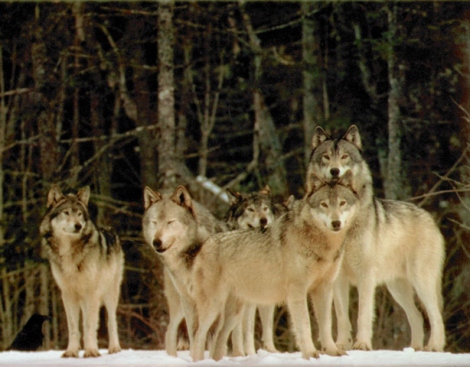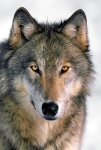It’s important to remember why we need wolves.
October 29, 2009
Wolves effect their surroundings and bring life to the lands they inhabit. For sixty years elk browsed the meadows of the North Fork of the Flathead, in Montana. Their adversary, Canis Lupus, who had chased them through time, was gone, hunted to extinction in the West.
Then the wolf came home to it’s native habitat and dispersed the elk. This brought back the aspen and willow, young shoots no longer trampled under the complacent elk’s hooves. With the aspen came the songbirds and other wildlife.
Once more the circle was complete with the return of the great canine, the wolf.
“Aspen ecosystems are considered some of the finest and richest songbird habitat on the continent, second only to river-bottom riparian zones. Remove the wolf, and you remove the songbirds. Remove the songbirds, and the bugs move in. Everything changes, top to bottom, right down to the dirt”…..Cristina Eisenberg, Oregon State University researcher
===
Wolves Increase Biodiversity And Greatly Benefit The Ecosystems They Inhabit
Matt Skoglund Wildlife Advocate, Livingston, Montana
Posted October 26, 2009 in Saving Wildlife and Wild Places
Wolves matter.
They lead to more songbirds. Better trout habitat. More game birds. Less insects. Better soil. Fewer coyotes. Wilder elk. More aspen trees.
Wolves, in essence, are key to a healthy landscape.
So says biologist Christina Eisenberg in a fascinating Missoulian article on the effect of wolves — and their absence — on an ecosystem.
Eisenberg has been studying the top-to-bottom effect of wolves — called a “trophic cascade” — in Glacier National Park for years. She’s also been researching ecosystems near St. Mary’s, Montana, and in Waterton Lakes National Park in Alberta, Canada.
“Each study site is about the same size, and each has a similarly large elk population, native to an aspen-based winter range, and each has the same general density of cougars and bears.” The difference between the sites is the number of resident wolves: St. Mary’s has none, Waterton some, and Glacier many.
Her findings on the much heated debate over wolves and elk mirror what others have found: there are plenty of elk in the Northern Rockies, but the return of wolves has made the elk behave again like wild elk:
The North Fork, Eisenberg said, is “full of wolves,” and has been for 20 years now. It’s also full of elk – as many as 14 elk per square kilometer in this meadow, where the wolf den site is located. Elk scat litters the ground not 20 yards from the den.
Clearly, the wolves aren’t eating all the elk. But aside from the tracks and the scat and the bones and the antlers, there are no elk to be seen.
“They’ve totally changed their behavior,” Eisenberg said. “For 60 years we’ve become used to complacent elk. These elk aren’t complacent. They’re on high alert.”
From a browse standpoint, that means elk eat a bit and move on, eat a bit and move on, never standing in one place long enough to eat a tree down to its roots. And from a human standpoint, it means hunters see far fewer elk even as state wildlife officials insist Montana has more deer and elk than it’s had for years.
…
Hunters, of course, prefer elk that aren’t quite so wily, but trophic cascades work both ways in wildlife management. Remove the wolves, and elk are easier to find. But then coyote populations explode, eating their way through the local game-bird population. Enhance one hunting opportunity, and you affect another.
And from a bigger viewpoint than just elk, Eisenberg has found that wolves increase biodiversity and greatly benefit the overall health of the areas they inhabit:
Remove the wolves, she said, and you lose the birds.
Remove the wolves, she said, and the coyotes fill the niche. The coyotes eat the ground squirrels, and so the meadows don’t get “plowed,” and soil productivity declines.
Remove the wolves, she said, and the deer eat the river-bottom willows, and the bull trout lose both their shade and their food, as insects no longer fall from overhanging brush.
Remove the wolves, she said, “and everything changes.”
Why is this so noteworthy?
[B]ecause the places with greatest biodiversity are the places most resilient, most able to adapt to, say, changing climate.
And Eisenberg wisely thinks her — and others’ — findings should guide wolf management.
Wolf populations aren’t recovered with 12 breeding pairs, or 15, or 20, Eisenberg said. They’re recovered when there are enough wolves and other top-end predators to maximize biodiversity.
Her findings are important, and they’re timely, as wolves are being gunned down all over Idaho and Montana right now.
In her research and in this article, Eisenberg simply and unequivocally points out a critical fact that’s been lost in the recent debate over the wolf hunts:
Wolves matter.
http://switchboard.nrdc.org/blogs/mskoglund/wolves_increase_biodiversity_a.html
=============================================
Tracking science: Biologist’s findings show forest diversity, health influenced by wolves

http://www.missoulian.com/lifestyles/territory/article_3ec9fc54-c01f-11de-bf16-001cc4c002e0.html
Photo: first people
Photo: wolf wallpaper
Categories posted in: biodiversity, wolf recovery, gray wolf, Glacier National Park
Tags: wolf recovery, gray wolf, biodiverstiy









 Boulder White Clouds Council
Boulder White Clouds Council Exposing The Big Game
Exposing The Big Game Footloose Montana
Footloose Montana Friends of the Clearwater
Friends of the Clearwater Lockwood Animal Rescue Center
Lockwood Animal Rescue Center Louise du Toit
Louise du Toit LUPUSLAETUS
LUPUSLAETUS Mercy For Animals
Mercy For Animals Northern Idaho Wolf Alliance (NIWA)
Northern Idaho Wolf Alliance (NIWA) Predator Friendly®- Because Wildlife Matters
Predator Friendly®- Because Wildlife Matters Project Coyote
Project Coyote Project: Wolf
Project: Wolf The Nature Conservancy
The Nature Conservancy The Ravensong Group
The Ravensong Group WildEarth Guardians
WildEarth Guardians Wisconsin Wildlife Ethic-Vote Our Wildlife
Wisconsin Wildlife Ethic-Vote Our Wildlife Wolf And Wildlife Studies: Jay Mallonee (Independent Wolf Biologist)
Wolf And Wildlife Studies: Jay Mallonee (Independent Wolf Biologist) Wolf Song of Alaska
Wolf Song of Alaska Wolves in english ! Les loups en anglais !
Wolves in english ! Les loups en anglais ! WWP's Gray Wolf Page
WWP's Gray Wolf Page Yellowstone To Yukon Conservation Initiative
Yellowstone To Yukon Conservation Initiative
I like the brotherhood between these wolves
LikeLike
Hi abdrahman,
They definitely have each other’s backs. Extremly family oriented, social animals.
LikeLike
Really nice pic of the Blackwolf. What a beauty!
LikeLike
I know…how could anyone kill somethiing that magnificent? It’s beyond me??
LikeLike
Are they more than just a beauty? These wolves are becoming nearly extinct, although most of the gray wolves are held in yellowstone national park, the poaching, the killing of this species is uncalled for, and is absolutely, not neccessary. When the wolves increase significantly in their population over time, they WILL, have a chance. Then someday they will go back to their normal lifestyle. Killing omnivores, and many other herbivores.
LikeLike
Hi i’m a native (mi’kmaq). These pictures are just so great. Anyway i think your right, Wolves are here to bring peace, wisdom, & humility-(IDK what word is). But in my culture we respect animals, & all livivng things. Where i live were surronded by mountians, islands, & lakes. My grandad owns almost half of the mountains so he takes me up there everytime he gets a chance. It’s really beautiful up there. Everyone thinks theres no wolves up there. But I think they are there (and other animals), deep in the mountains where theres peace everywhere. We just cant here or see them. Anyway, KEEP PROTECTING THEM!!!
Love: Janaya Paul
LikeLike
Greetings Janaya…
As a native I welcome your opinion on wolves. If only your culture’s values dominated the people that are “managing wolves”, to allow them to live in peace without harrassment.
It must be beautiful in your grandad’s mountains and yes there are probably wolves there, as you believe. Hopefully they will stay well hidden and live out their lives the way they are meant to.
Thanks so much for reading!
For the paqtism, For the wild ones,
Nabeki
LikeLike
[…] new fairy tales about wolves, instead of the ”The Big Bad Wolf” eating grandma. How about the wolves that saved the aspen and willow trees? Or having wolves on the landscape helps the Pronghorn antelope […]
LikeLike